
1712. C. jaTántca.
raention® two v a rie tie s: C .j.
C ? t e r r r i f t e t i " ' ? a „ d c . j . C. mtnuis Lindl. in Wall. PI. As. R a r. is a nati vfeu coéfs cSeinnsg.a p(oBrleu. n i .)
L. diincnsis Spreng. is mentioned in our HoHus Britannicus.
G e n u s IV .
I j
C A 'R P IN U S L . T h e H o rm ie am . L in . Syst. Monoe'cia Polyandria.
IdrntficaUon. hin. Gen., 4Q7.-, Juss., 409. ; Tl. Br., 1029. : N. Dii TTain 9 n lo?
2<V. ; Ilaynbuche, or Hainbuche, G<t • Cariiiiio'//i/ri
t e ri“ '''" “ ' “fore'’ »resile, cylindrical. B ra d e r
imbricate, consisting o f 12 o r more stamens inserted a t th e base
• Z ' bearded a t th e tip, 1-celled. — fiowers in lax
? ? ? ó t'te r bracteas
ontiie, soon falling o ff; inner bracteas in pairs, each 3-lobed. Calnx clotli-
Z Î ®, to near its tip , and adhering to it ; toothed a t th e tip. Sink
S . r i t e ' “ ’ ‘0"g.,tl'read-sha|>cd. F ru it n o t a ttended by the
r I I .“i™ ri “ ‘"p ressed, ribbed, clothed except a t th e base; ami
tipped with th e adnate calyx ; woody ; including one seed. (G . Don )
Leavas simple a ltern ate, exstipulate, deciduous ; feather-nerved, plaited
X » ri''™«-® '''-■‘■y small, g r e e n is h .-- Trees, mostly o f th e middle
s iz e , natives o f Eu ro p e , th e Levant, and North America ; little valued
cither for the ir timber or ornamental effect ; b u t one species valuable as a
garden hedge plant. Common soil, and seeds o r layers.
¥ 1. C. - S e 'tu lu s L . T h e Birch, or common. Hornbeam.
Id en tific a tio n . L in . S p . P l . , 1416. ; E n g . B o t . , t . 2032.
S y n o n ym e s . C& rp in u s M a t th . V a lg r . I . p . 1 3 1 .; O 's t r y a B a u h . B i n . 4 2 7 . ; O 'r n u s T r a g . H i s t .
1109.; F à g u s B a u h . H is t. 1. p . 2 . 146. f. ; F e t i i l u s L o b . I c . 2. 190. f. ; C a r n e , C h a rm e , F r . ;
g em e in e H a y n b u c h e , Ger. j C a r p in o b ia n c o , H a l . ; H o r n b e am , Y o k e E lm , a n d in s om e p la c e
W y ch h a z e l.
E n g r a v in g s . E n g . B o t . , t . 2032. ; N . D u H am . , 2 . t . 5 8 . ; t h e p l a t e s o f t h i s t r e e in A rb . B r i t . , 1 s t
e d it., v o l. v i i i . ; a n d o u r j f g . 1713.
Spec. Char., S/c- Brac teas o f th e fruit flat, oblong, serrated , with two lateral
lobes. (Smith.) A deciduous tre e. Britain, and various p arts o f E u rope,
in magnitude and general ch a ra cte r resembling th e common beech.
Height 3 0 ft. to 7 0 ft. Fiowers y ellow ish ; May. Nu ts b row n ; ripe in
October o r November.
Varieties.
¥ C. B. 2 incìsa Lodd. Cat. 1836. C. B . ^uercifòlia Desf. ,C . -ff.heterophylla
Hoi't. — Leaves deeply cut.
¥ C. B. 3 variegàta Lodd. Cat. 1836. — Lcavcs variegated.
The hornbeam, being extremely p atien t o f tlie knife, forms excellent iiedges.
The wood is very tough and horny, and th e bark smooth and whitish, o r liglit
1713. C. Oétulus.
grey spotted with white ; and on old tre es it is generally covered with a
brownish moss. T h e wood is white, hard, heavy, tenacious, and very close-
framed ; but it will n o t tak e a good polish. I t weighs, when green, 64 lb. ;
half-dry, 57 lb. ; and quite dry, 51 'lbb.. I t is3 1very seldom used in construc tion ;
partly because it is seldom found o f pro p er dimensions, and p artly because,
when the tree attains a large size, th e wood is a p t to become shaky, like th a t
of the chestnut. As fuel, it surpasses th e beech in th e p roportion o f 1655
to 1540. F o r a nurse plant, and for hedges, it is particularly w’ell adapted.
It will succeed in any soil n o t to o warm and dry. I t is naturally found on cold,
3 N 3
'ri
ri